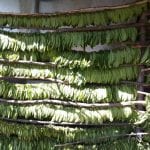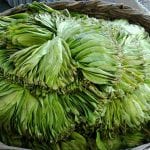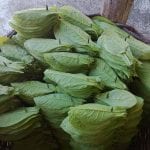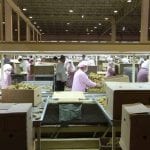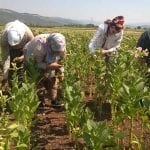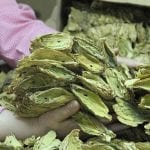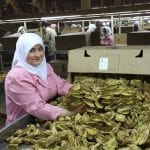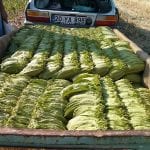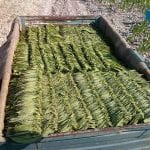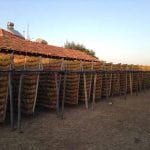Feeling the chill

The changing global cigarette market has left its mark on the classical oriental tobacco sector.
By Stefanie Rossel
For classical oriental tobacco, 2016 marks an anniversary. It was 10 years ago that in Greece—previously the European Union’s top tobacco producer—tobacco was “decoupled” from EU subsidies. Since then, the global market for the aromatic, sun-cured leaf that gives American-blend cigarettes their characteristic taste has changed considerably. The volume of oriental tobacco produced worldwide today is about the same as that produced by just Greece prior to decoupling.
In 2015, global production of classical oriental leaf tobacco declined again. According to figures provided by Sunel Tobacco Co., the combined crop of the world’s four leading oriental producing countries (Turkey, Greece, Macedonia and Bulgaria) was expected to amount to 108,000 tons, down from 126,000 tons in 2014 and far from the 154,000 tons in 2013. Including semi-oriental varieties from countries such as China, Thailand, India and Kyrgyzstan, total global oriental production was forecast at 162,000 tons in 2015, down from 184,000 tons in the previous year.
“Total production of classical oriental leaf in the four countries seems to settle down to a figure much lower than the 2013 crop peak, and much more in line with the current demand for this type of tobacco in the international market,” says Nikos Allamanis, secretary of the Hellenic Inter-Professional Organization of Raw Tobacco and president of the board of directors of the Hellenic Association of Tobacco Processing Industries. Demand, however, is expected to shrink due to declining consumption of American-blend cigarettes in the develop world.
“In general we see a slowdown on demand due to reduction in cigarette sales that occurred mainly in the EU and Russia,” observes Frederick de Cramer, general manager of Sunel. Also, weak local currencies have slowed imports in Southeast Asian countries such as Indonesia. “The multinationals are carrying larger durations or stocks than their normal average so they seem to be adjusting them,” says de Cramer.
Allamanis sees the growing popularity of illicit cigarettes, which typically are made without high-priced classical oriental tobaccos, and e-cigarettes—which don’t contain any tobacco—as further negative factors.
Nevertheless, the future of oriental leaf production may brighten in at least one big cigarette market, according to de Cramer: “The U.S. decline [in cigarette sales] has slowed down from a traditional minus 4 percent per annum to minus 2 percent or less. This should bring some additional momentum to the oriental market. The volumes are down. … We anticipate a correction, i.e., an increase once we have hit the bottom, which is anticipated with the 2016 crop.”
Turkey, which produces the classical varieties Izmir, Samsun and Basma, remains the world’s largest exporter of oriental; in 2014, it accounted for 33 percent of global oriental tobacco production. In 2015, however, the figure was expected to be only 60,000 tons, down from 67,800 tons in 2014, according to de Cramer.
Contrary to the forecasts made at the time of decoupling, Greece is still in the game and ranks second among oriental tobacco producers. In 2015, it accounted for an estimated 15 percent of global oriental production. Its 22,000-ton harvest included 13,500 tons of Basma and 8,500 tons of Katerini, according to Allamanis. As in the other oriental-cultivating countries, Greece’s 2015 crop was smaller than that of the previous year, which stood at approximately 25,500 tons—a reversal of the trend following the overproduction of oriental tobacco in the preceding two years, Allamanis says. Production in Macedonia, which with its Prilep and Yaka varieties accounts for 14 percent of global oriental supply, was expected to reach 22,000 tons in 2015, down from 26,000 tons in the previous year, according to Sunel figures. Bulgaria holds the fourth place among oriental producing countries, with an estimated share of 6 percent or 9,000 tons in 2015.
Fewer farmers, more alternatives
Although Turkey, as a non-EU member state, has been unaffected by decoupling, its oriental production volumes, too, are a shadow of what they used to be. The decline started with the 2009 privatization of Turkey’s former state tobacco monopoly, Tekel, which until then had bought all unsold tobaccos at declared prices, thus artificially boosting production, accumulating large inventories and distorting the market.
The end of state intervention made tobacco growing a less attractive business for farmers, leading to a record-low crop of 41,000 tons in 2011. And there is no guarantee this mark won’t be undercut in the future, according to de Cramer. “The real alarming number is [for] the classical Izmir type, which is down from 49,000 tons to 42,000 tons, or minus 14.4 percent,” he says. “Next year, we expect another drop, to 35,000 tons. This will depend on how much the industry is willing to pay to the farmer, i.e., how much the demand will be.”
Turkey’s tobacco crop is produced by some 60,000 farmers, a number that has been shrinking over the past years. This development cannot be attributed exclusively to Tekel’s privatization. As Turkey’s economy thrived in recent years, people have been leaving rural areas for better-paying jobs in the cities. De Cramer expects the situation to exacerbate with a rise in the minimum wage that was scheduled to take effect at the start of this month.
In addition, tobacco today is less competitive as a cash crop than it was in the past. “Alternative crops, such as vegetables, olives, oregano, melons, strawberries and grapes, have given better returns than tobacco, so the farmers are switching,” de Cramer says. The future, he says, will depend on the green price and the support the industry is willing to give. “If the demand is not there and prices are at inflation level or below, we could see a slide of 25 percent or more.”
Tobacco farmers are also struggling with the impact of climate change. “Weather patterns have changed so the risk of having a low production and/or quality is high,” says de Cramer. “Last year we had continuous rains until the end May so the transplanting was delayed. Then we had eight weeks of extreme heat with more than 38 degrees Celsius, so the low-stalk and, in certain areas, the mid-stalk tobacco was damaged or overripe as the farmer could not harvest the crop on time. This has been the case now two years in a row, so the farmer is also worried that he cannot produce a good and healthy crop. The risk of hail damage has increased with these extreme weather conditions.”
To support oriental tobacco growers, Sunel is trying to help them increase their yields and acreage. This, it hopes, will give farmers a better return without jeopardizing their tobacco quality. Meanwhile, the industry has introduced a system, known as the sock method, to cure more efficiently. With the help of a machine that ventilates the leaves, oriental tobacco is inserted into a hose-shaped net, which is then hung up between two poles under a plastic cover for sun-curing. The new method requires less effort and, importantly, saves labor cost.
The steps of the process must be carried out meticulously, however, because failing to stick to the guidelines can affect tobacco quality. “This is an ongoing exercise that we are conducting on a trial basis,” explains de Cramer. “Unfortunately some companies have jumped the gun and introduced the curing method without giving the farmers the necessary explanation, and this is deteriorating the quality. Once we know that the quality can be achieved with the sock method then it will be spread on a large scale.”
As in Greece, organic oriental leaf has been making inroads in Turkey, led by Sunel. De Cramer anticipates a total organic crop of 2,700 tons in 2015. “The farmer is happy with the additional 20 percent green price return and also support on fertilizer, organic pesticides, land lease support, etc.,” he says. “Yields are slightly lower [compared with] the traditional oriental, but with time this gap should be minimized. The additional work due to extensive spraying is the main disadvantage.”
Back to the golden leaf
Greece has recently experienced a rather opposite development to Turkey. Looking back at the decoupling 10 years ago, Allamanis sees both negatives and positives.
“On the negative side, the sector of tobacco cultivation, processing and commerce has been considerably diminished with a significant loss of GDP for the country,” he says. “The main losers were the people offering services to the tobacco cultivation business and not the growers.”
The tobacco processing industry, in particular, was hit hard. Out of 22 tobacco processing factories operating in 2005, only four remain, according to Allamanis. Some 70 percent of the employees and the service providers in the sector lost their jobs.
On the positive side, the supply of raw tobacco came more in line with the types and the quality of tobacco demanded in the international market, and consequently prices have increased considerably. “Although 70 percent of the production has been lost and the volume of exports of Greek tobacco decreased by approximately 60 percent comparing crop year 2005 to 2014 figures, the value of these exports decreased only by one third,” says Allamanis.
In addition to oriental styles, Greek farmers grow small amounts of burley and flue-cured Virginia (FCV), with 300 tons and 8,000 tons, respectively, grown in 2015. Allamanis is content with the country’s latest crop: “Prices of village tobacco in Greece were considerably lower for the 2014 crop, due to the very poor quality of this crop, which itself was solely due to adverse weather conditions,” he explains. “2015 was a fair to very good crop, and prices [per kg] are expected to average at €4.25 ($ 4.66) for Basma, €3.80 for Katerini and €2.20 for FCV, as compared with 2014 crop’s €3.70, €3.40 and €2.00, respectively.”
Alexandros Kontos, general manager of tobacco company Seke, believes the better 2015 crop prices will boost production of Basma and Katerini. His company, he says, was the first to introduce organic tobacco cultivation in Greece and has been focusing on this kind of production during the past three years (see also “Holistic approach” on page xx).
In contrast to Turkey, Greece’s GDP has been declining continuously since the country went into a recession in 2008. In 2010, the country had slipped into a government debt crisis that culminated in 2015 and remains unsolved. For Greek tobacco production, however, the economic crisis has had a rather positive impact, as Allamanis points out.
“The economic depression halted the urbanization trend, since unemployment is hurting the cities far more than the countryside,” he says. “There are no recent statistics available, but it is obvious that many people moved back from the big cities to their villages or their towns, or have emigrated abroad. Many growers who had abandoned tobacco cultivation in the past came back to this activity; FCV growers are a good example, as the production of this type in 2006 to 2009 was nil. Some new growers also came into the business. The number of tobacco growers in the country increased from the low of 13,000 post-decoupling to approximately 16,500 today.”
Kontos has observed the same development. “Young people who faced limited job opportunities in other sectors turned their interest to, among other [activities], tobacco cultivation, seeing it as a chance to ensure an income, especially in regions where any other type of cultivation, such as cotton, wheat, maize or sugar beets, is neither profitable nor feasible.”
In 2013, the European Commission introduced, as part of its revised Common Agricultural Policy (CAP), a new direct-payments regime to support EU farmers in the form of uncoupled income subsidiaries, the so-called single-farm payments. Allamanis believes the shift toward a hectare-based income support, irrespective of the type of production and its labor costs, will diminish considerably the support to tobacco growers who have been benefiting from a high per-hectare subsidy in the past.
“Although the new CAP provides for a certain level of coupled support, through a political decision, tobacco has been excluded. Finally, specific measures for the support of tobacco cultivation through agro-environmental subsidies have been terminated. We can therefore state that tobacco growers, apart from the diminishing income subsidy, enjoy no other specific support from the EU CAP and the sector is realizing that it will have either to stand on its own feet or collapse.”
Nevertheless, Allamanis believes that tobacco growing will have a future in Greece: “Our forecast, notwithstanding the threats currently affecting the tobacco sector in general, is that the oriental leaf production will remain stable in Greece at the level of around 22,500 tons in the foreseeable future.”
The country’s tobacco sector is supported by leading cigarette companies such as Philip Morris International (PMI), which has invested significantly in its Papastratos subsidiary over the past two years. PMI has also entered into a three-year strategic agreement with the Greek government for the purchase of Greek oriental tobacco; discussions about a renewal of the agreement are underway, according to Allamanis. “It is obvious that this policy brings considerable stability in the demand and therefore in the production of Greek oriental,” he says.

